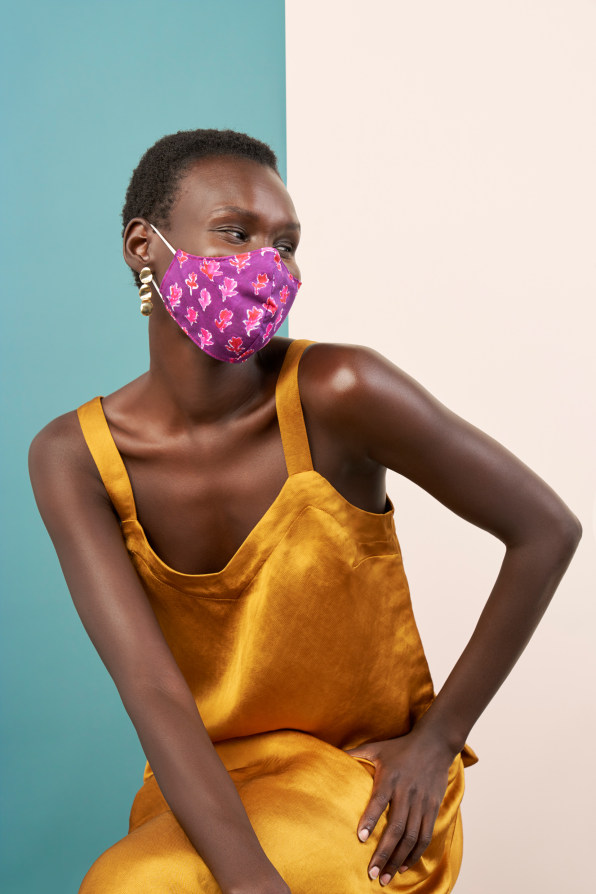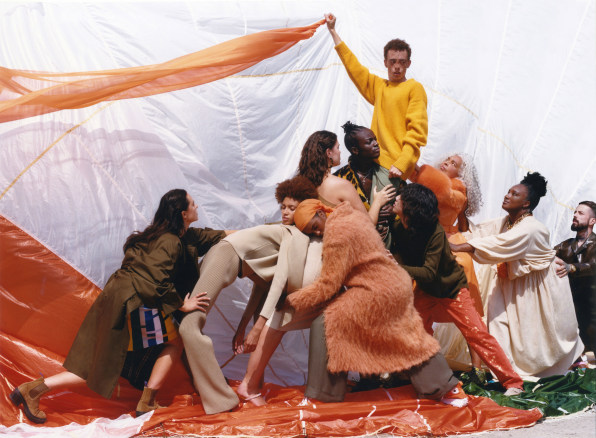Designer Prabal Gurung, Farfetch CEO José Neves, CFDA’s Steven Kolb, and Vestiaire Collective’s Clara Chappaz offer a preview of upcoming seasons.

For Fast Company’s Shape of Tomorrow series, we’re asking business leaders to share their inside perspective on how the COVID-19 era is transforming their industries. Here’s what’s been lost—and what could be gained—in the new world order.
Every September for the past 10 years, designer Prabal Gurung has unveiled his latest creations at New York Fashion Week. “A fashion show is rather magical,” he says. “For six months, we go through the arduous and exciting process of creating. And for 10 minutes, we share that energy and emotion with the world. ”
But not this year. As the pandemic raged across the United States, Gurung—like many other designers—made the painful decision to cancel his show. The few designers who pushed forward—such as Jason Wu and Rebecca Minkoff—showed their collections in cavernous, sparsely filled spaces. “It was unlike any fashion week before, with the exception of September 11th,” says Steven Kolb, CEO of the Council of Fashion Designers of America (CFDA).
It wasn’t just that the glamour, celebrity, and theater of NYFW had disappeared. Kolb points out that there were also financial consequences: no buyers to place orders, or magazine editors to drum up excitement about upcoming trends. Over the last six months, COVID-19 has pummeled the $2.5 trillion global fashion industry. With nowhere to go and unemployment on the rise, consumers have lost interest in buying clothes and shoes. McKinsey predicts that the sector will contract by up to 30% this year compared to last; the luxury market will be hit even harder, contracting by up to 39%. Many across the global fashion supply chain have already been hurt, from the garment workers who have been laid off to designers stuck with piles of unsold inventory.
At the same time, however, many industry insiders believe that the pandemic could be a rare opportunity for the industry to reset itself. Designers are using this moment to start selling products online and connect with customers more directly. They’re thinking about how to rebuild the supply chain in a more ethical, sustainable way, to end the cycle of overconsumption and overproduction. “The rules were set in the industry a century ago, and we’re still following them,” Gurung says. “This pandemic has allowed us to reimagine everything.”
The Digital Imperative
The pandemic has forced designers to rethink how they reach customers. Since the beginning of American fashion, labels have sold their clothes through department stores and boutiques. But over the past decade, as brick-and-mortar retail has been on the decline, this has been an increasingly losing strategy. When pandemic-related lockdowns went into effect in March, these retailers were dealt yet another blow. With little revenue coming in, many were driven to the verge of collapse. Iconic brands such as Lord & Taylor and Neiman Marcus have declared bankruptcy. This affected designers, who were stuck with piles of unsold inventory at the end of the season. “American designers aren’t part of big conglomerates like LVMH or Kering,” says Kolb. “We’re an industry of small brands that don’t have access to big resources or teams. This contributed to a lack of preparedness for a crisis like this.”
designer Prabal GurungAt the end of the day, the consumer is the one we need to talk to.”
Gurung has been pursuing both avenues. He began his career with a traditional wholesale business, selling to high-end department stores such as Saks and Barneys, along with a private client business. But over the last few years, he’s invested in reaching consumers directly on social media and has begun selling collections directly from his website. Recently, he’s been leaning into these channels, which may pay off after the pandemic. And in a big move, Gurung launched a new, affordably priced brand called Impower that is sold exclusively on Walmart.com. The line has a philanthropic component, with a portion of sales donated to social justice initiatives, and it’s also a new channel for Gurung to reach customers online. “At the end of the day, the consumer is the one we need to talk to,” he says.

The Fate of the Boutique
But José Neves, founder and CEO of luxury fashion marketplace Farfetch, says that not all designers can build this direct-to-consumer relationship overnight. It takes years, and millions of marketing dollars, to build an online following. Small, emerging designers depend on retailers to get in front of customers. And customers, for their part, rely on these retailers to surface new brands and carefully curate products. That’s why Neves believes that retailers—particularly small, independent boutiques—will continue to have a place in our future. “Curation will continue to be essential,” he says. “These boutiques are a crucial part of the fashion ecosystem. People often see the fashion industry as a very competitive landscape, but I disagree: We all need each other.”
Farfetch is familiar with the global landscape of small fashion and luxury boutiques. Neves launched the company in 2007 to connect customers to more than 800 boutiques around the world, which collectively sell products from more than 3,500 designers. The pandemic devastated these small boutiques, which don’t have the same access to capital as the bigger department stores to get them through months of diminished sales. For many retailers within Farfetch’s directory, sales on the platform were the only revenue that came in during the lockdowns. Fortunately for them, many customers turned to Farfetch over the last six months: Half a million new customers joined the site, driving up site traffic by 60% and resulting in a 48% surge in second-quarter revenue, year over year.
Neves believes that once the crisis is over, people will return to physical stores. But one lesson from the crisis is that it is important for all the players in the fashion industry, from designers to boutiques, to invest in digital channels. “I don’t think there is any scenario in the future in which fashion will exist online only,” Neves says. “Fashion is a physical object: We’ll never be able to entirely digitize it, the way Spotify did with music or Netflix did with movies. But fashion needs to embrace digital if it is to survive.”
A More Sustainable Future
The fashion industry will, eventually, make a comeback. McKinsey believes that positive growth will return as soon as 2021, though it will be a modest increase of no more than 4%. But one big question is whether our fashion sensibilities will have permanently changed, after years of being stuck at home wearing sweats and pajamas. During the pandemic, many designers have started creating loungewear for the first time. All of the experts I spoke with believe that this focus on casual, comfortable clothes is short-lived. Designer and CFDA president Tom Ford pointed out to WWD that after the austere years of the 1918 Spanish flu, fashion came back in a big way with the Roaring 20s. “Fashion is a pendulum,” says Kolb. “It shifts from one extreme to another, and that will happen again here.”
CFDA CEO Steven KolbFashion is a pendulum. It shifts from one extreme to another, and that will happen again here.”

Gurung says that designers are also pondering their environmental footprint. He was recently selected to be part of a CFDA residency focused on rebuilding his supply chain to make it more eco-friendly. But over the last six months, he’s been thinking about his impact in deeper ways. For years, people have talked about fashion as superficial, focused on helping people escape reality through beautiful, expensive garments. But Gurung believes the role of the fashion designer has shifted. “Fashion doesn’t exist in a vacuum—we’re part of culture,” Gurung says. “Designers are storytellers: The only time any of us should design a collection is if we have something substantial to say.”
More from Fast Company’s Shape of Tomorrow series:
- Why performance reviews may be a thing of the past
- Is advertising really dead? Here’s how the leaders of Droga5, TBWA, Wieden+Kennedy, and more are inching forward
- The retail Armageddon may have finally arrived. Here’s what top executives at Nike, Athleta, and more believe it will take for stores and brands to make it through
- Insiders at LinkedIn, Glassdoor, and Jobcase tell us which companies will be hiring, what skills will be important, and how the workplace of the future will change
- How COVID-19 has changed investing, according to VCs at Sequoia, Insight, Forerunner, 500 Startups, and more
- Architects and urban planners from Gensler, Harvard, and Bloomberg Associates explain the changes coming to our shared spaces
- Insiders at Burning Man, Broadway, Meow Wolf, and more describe how the live events industry will emerge onto a new stage
- Planned Parenthood’s president on surviving the pandemic and bracing for battle with the Supreme Court
- Watch out Amazon: Walmart could be the comeback story of the COVID-19 era. Here’s how brand perception is changing
- Insiders at ad agencies BBDO New York, McCann Worldgroup, and more on how client relationships, production, and hiring may never be the same
"industry" - Google News
October 30, 2020 at 06:00PM
https://ift.tt/2HNzJoA
4 fashion insiders reveal how COVID-19 is altering the industry - Fast Company
"industry" - Google News
https://ift.tt/2RrQtUH
https://ift.tt/2zJ3SAW
Bagikan Berita Ini















0 Response to "4 fashion insiders reveal how COVID-19 is altering the industry - Fast Company"
Post a Comment